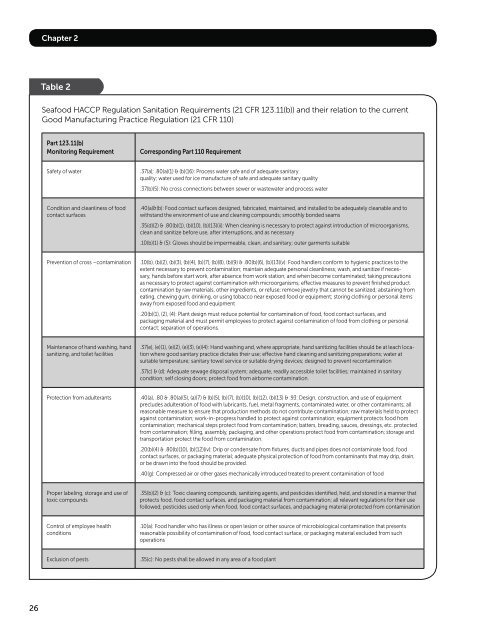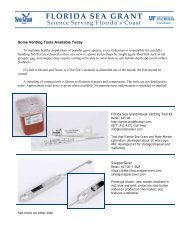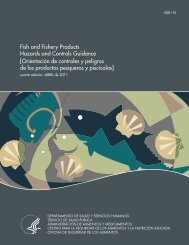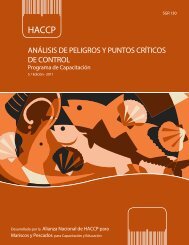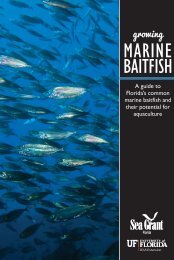HACCP
Hazard Analysis and Critical Control Point - Florida Sea Grant
Hazard Analysis and Critical Control Point - Florida Sea Grant
- No tags were found...
You also want an ePaper? Increase the reach of your titles
YUMPU automatically turns print PDFs into web optimized ePapers that Google loves.
Chapter 2<br />
Table 2<br />
Seafood <strong>HACCP</strong> Regulation Sanitation Requirements (21 CFR 123.11(b)) and their relation to the current<br />
Good Manufacturing Practice Regulation (21 CFR 110)<br />
Part 123.11(b)<br />
Monitoring Requirement<br />
Corresponding Part 110 Requirement<br />
Safety of water<br />
.37(a); .80(a)(1) & (b)(16): Process water safe and of adequate sanitary<br />
quality; water used for ice manufacture of safe and adequate sanitary quality<br />
.37(b)(5): No cross connections between sewer or wastewater and process water<br />
Condition and cleanliness of food<br />
contact surfaces<br />
.40(a)&(b): Food contact surfaces designed, fabricated, maintained, and installed to be adequately cleanable and to<br />
withstand the environment of use and cleaning compounds; smoothly bonded seams<br />
.35(d)(2) & .80(b)(1), (b)(10), (b)(13)(ii): When cleaning is necessary to protect against introduction of microorganisms,<br />
clean and sanitize before use, after interruptions, and as necessary<br />
.10(b)(1) & (5): Gloves should be impermeable, clean, and sanitary; outer garments suitable<br />
Prevention of cross –contamination<br />
.10(b), (b)(2), (b)(3), (b)(4), (b)(7), (b)(8), (b)(9) & .80(b)(6), (b)(13)(v): Food handlers conform to hygienic practices to the<br />
extent necessary to prevent contamination; maintain adequate personal cleanliness; wash, and sanitize if necessary,<br />
hands before start work, after absence from work station, and when become contaminated; taking precautions<br />
as necessary to protect against contamination with microorganisms; effective measures to prevent finished product<br />
contamination by raw materials, other ingredients, or refuse; remove jewelry that cannot be sanitized; abstaining from<br />
eating, chewing gum, drinking, or using tobacco near exposed food or equipment; storing clothing or personal items<br />
away from exposed food and equipment<br />
.20(b)(1), (2), (4): Plant design must reduce potential for contamination of food, food contact surfaces, and<br />
packaging material and must permit employees to protect against contamination of food from clothing or personal<br />
contact; separation of operations.<br />
Maintenance of hand washing, hand<br />
sanitizing, and toilet facilities<br />
.37(e), (e)(1), (e)(2), (e)(3), (e)(4): Hand washing and, where appropriate, hand sanitizing facilities should be at leach location<br />
where good sanitary practice dictates their use; effective hand cleaning and sanitizing preparations; water at<br />
suitable temperature; sanitary towel service or suitable drying devices; designed to prevent recontamination<br />
.37(c) & (d): Adequate sewage disposal system; adequate, readily accessible toilet facilities; maintained in sanitary<br />
condition; self closing doors; protect food from airborne contamination.<br />
Protection from adulterants<br />
.40(a), .80 & .80(a)(5), (a)(7) & (b)(5), (b)(7), (b)(10), (b)(12), (b)(13) & .93: Design, construction, and use of equipment<br />
precludes adulteration of food with lubricants, fuel, metal fragments, contaminated water, or other contaminants; all<br />
reasonable measure to ensure that production methods do not contribute contamination; raw materials held to protect<br />
against contamination; work-in-progress handled to protect against contamination; equipment protects food from<br />
contamination; mechanical steps protect food from contamination; batters, breading, sauces, dressings, etc. protected<br />
from contamination; filling, assembly, packaging, and other operations protect food from contamination; storage and<br />
transportation protect the food from contamination.<br />
.20(b)(4) & .80(b)(10), (b)(12)(iv): Drip or condensate from fixtures, ducts and pipes does not contaminate food, food<br />
contact surfaces, or packaging material; adequate physical protection of food from contaminants that may drip, drain,<br />
or be drawn into the food should be provided.<br />
.40(g): Compressed air or other gases mechanically introduced treated to prevent contamination of food<br />
Proper labeling, storage and use of<br />
toxic compounds<br />
.35(b)(2) & (c): Toxic cleaning compounds, sanitizing agents, and pesticides identified, held, and stored in a manner that<br />
protects food, food contact surfaces, and packaging material from contamination; all relevant regulations for their use<br />
followed; pesticides used only when food, food contact surfaces, and packaging material protected from contamination<br />
Control of employee health<br />
conditions<br />
.10(a): Food handler who has illness or open lesion or other source of microbiological contamination that presents<br />
reasonable possibility of contamination of food, food contact surface, or packaging material excluded from such<br />
operations<br />
Exclusion of pests<br />
.35(c): No pests shall be allowed in any area of a food plant<br />
26


